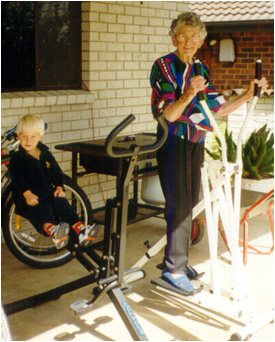At the risk of a potential domino effect, I ask 170 retirees to stand on one leg. For those that already aren’t too wobbly, I ask them to close their eyes. The room sways… and is soon followed by much laughter.

Last week I was asked to speak to a Probus group at the Castle Hill Community Centre. This is a group of active retirees keen to learn more about themselves, and maintain a fulfilling and active lifestyle. After the laughter settles I discuss the seriousness of not having the ability to maintain posture and balance. One in three adults over the age of 65 suffers from a fall each year and 10% of these falls lead to a significant injury resulting in hospitalisation. Of these, up to 80% do not go home! There is now a slight look of shock amongst the group.
In most cases, we lose our balance slowly, so our perception is that we don’t have a problem – until we fall. In the world we live in, our sensory system is not stimulated enough and so we lose motor feedback control over time. It deteriorates slowly as a result of walking on even, flat surfaces with our feet (sensory organs) bundled up in a shoe that has a hard, non-pliable, sole. We have forgotten how to “feel with our feet”. As a human species, and as “hunter gatherers”, we should be walking across rocky outcrops on undulating surfaces, barefoot – or with a piece of leather strapped to our sole. Instead, we have smooth concrete pathways from the shopping centre car park to the nearest smooth polished floors of the grocery store.
In a healthy, mechanically stable individual, the feedback between the toes, ankle, knee, hip, pelvis and spine should allow us to stand on one leg – with our eyes closed, for 60 seconds. Now, the average person is reasonable with their eyes open, but as soon as visual input is taken out of the equation, and we cannot fixate our gaze, many individuals struggle, and are capable of only a few seconds. Poor feedback between the joints, muscles and brain is exposed.
We know, from the research, that people who suffer chronic low back pain tend to have poor balance and body awareness. So, it is of crucial importance to maintain and improve our balance to avoid further, or future, damage to our bodies. One of the important brain structures for maintaining balance and stability is the cerebellum or “little brain”. It is situated at the back of our brain, and its job is to compare intended movement with actual movement. We can watch a cerebellum develop as we observe babies learning to walk, where they progress from wide, clumsy steps, to an even, narrow based walking position. We then learn to catch a ball, with repeated practice, and with time, feedback mechanisms ensure smooth and coordinated movements. Don Bradman, the great Australian cricketer, had trained his cerebellum in his youth, famously hitting a ball against a piece of corrugated iron with a stick.
Just as we can improve hand-eye coordination through practice, we can all improve our cerebellum using various exercises and training. And because it is the main brain area for posture and balance, this will help to prevent unnecessary falls.
To improve your balance at home, try standing on one leg. It is best to do this in a corner of the room facing the walls, to help support your balance if necessary. If you are confident, you can now close your eyes. Feel with your toes and feet the corrections you need to make to prevent yourself from overbalancing. If this is okay, make it a habit to stand on one leg while brushing your teeth, or doing the dishes. Make it a daily habit and in no time you will be able to achieve 60 seconds, on each leg, with the eyes closed.
At Shirley Rd Chiropractic (Crows Nest) we can pick up early signs of poor cerebellar function. This can be as simple as looking for head tilts, position while lying on the table, inability to perform rapid alternating movements with the hands or lack of smoothness of movement when touching the nose.
For issues or concerns with your balance or to learn more about balance, read more about proprioception.


Leave A Comment
You must be logged in to post a comment.